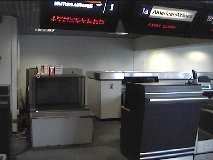Report Presented To House Transportation And Infrastructure
Committee
In a report presented Wednesday to the House Transportation and
Infrastructure Committee, the GAO said that TSA needs to develop a
better plan to screen for explosives in checked baggage on
airliners.

In the publicly-released report summary of a sensitive report
that GAO issued in May 2011, GAO says that explosives represent a
continuing threat to aviation security. The TSA, within the
Department of Homeland Security (DHS), seeks to ensure through the
Electronic Baggage Screening Program (EBSP) that
checked-baggage-screening technology is capable of detecting
explosives. Generally, the explosives detection system (EDS) is
used in conjunction with explosives trace detection (ETD) machines
to identify and resolve threats in checked baggage. As requested,
GAO assessed the extent to which: (1) TSA revised explosives
detection requirements and deployed technology to meet those
requirements, and (2) TSA's approach to the current EDS acquisition
meets best practices for schedules and cost estimates and includes
plans for potential upgrades of deployed EDSs. GAO analyzed EDS
requirements, compared the EDS acquisition schedule against GAO
best practices, and interviewed DHS officials.
TSA revised EDS explosives detection requirements in January
2010 to better address current threats and plans to implement these
requirements in a phased approach. The first phase, which includes
implementation of the previous 2005 requirements, is to take years
to fully implement. However, deploying EDSs that meet 2010
requirements could prove difficult given that TSA did not begin
deployment of EDSs meeting 2005 requirements until 4 years later in
2009. As of January 2011, some number of the EDSs in TSA's fleet
are detecting explosives at the level established in 2005. The
remaining EDSs in the fleet are configured to meet the 1998
requirements because TSA either has not activated the included
software or has not installed the needed hardware and software to
allow these EDSs to meet the 2005 requirements.

Developing a plan to deploy and operate EDSs to meet the most
recent requirements could help ensure EDSs are operating most
effectively and should improve checked-baggage screening. However,
TSA has faced challenges in procuring the first 260 EDSs to meet
2010 requirements. For example, due to the danger associated with
some explosives, TSA and DHS encountered challenges in developing
simulants and collecting data on the explosives' physical and
chemical properties needed by vendors and agencies to develop
detection software and test EDSs prior to the current acquisition.
Also, TSA's decision to pursue EDS procurement during data
collection complicated both efforts and resulted in a delay of over
7 months for the current acquisition. Completing data collection
for each phase of the 2010 requirements prior to pursuing EDS
procurements that meet those requirements could help TSA avoid
additional schedule delays.
TSA has established a schedule for the current EDS acquisition,
but it does not fully comply with best practices, and TSA has not
developed a plan to upgrade its EDS fleet. For example, the
schedule is not reliable because it does not reflect all planned
program activities and does not include a timeline to deploy EDSs
or plans to procure EDSs to meet subsequent phases of the 2010
requirements. Developing a reliable schedule would help TSA better
monitor and oversee the progress of the EDS acquisition. TSA
officials stated that to meet the 2010 requirements, TSA will
likely upgrade many of the current fleet of EDSs as well as the
first 260 EDS machines to be purchased under the current
acquisition. However, TSA has no plan in place outlining how it
will approach these upgrades.

Because TSA is implementing the 2010 requirements in a phased
approach, the same EDS machines may need to be upgraded multiple
times. TSA officials stated that they were confident the upgrades
could be completed on deployed machines. However, without a plan,
it will be difficult for TSA to provide reasonable assurance that
the upgrades will be feasible or cost-effective. GAO recommends
that TSA, among other things, develop a plan to ensure that new
machines, as well as those machines currently deployed in airports,
will be operated at the levels in established requirements, collect
explosives data before initiating new procurements, and develop a
reliable schedule for the EBSP. DHS concurred with all of GAO's
recommendations and has initiated actions to implement them.
The Washington Times reports that TSA has spend $8
billion since September 11th, 2001, to install the machines, many
of which are already obsolete.
 ANN's Daily Aero-Linx (04.16.24)
ANN's Daily Aero-Linx (04.16.24) Aero-News: Quote of the Day (04.16.24)
Aero-News: Quote of the Day (04.16.24) Airborne 04.10.24: SnF24!, A50 Heritage Reveal, HeliCycle!, Montaer MC-01
Airborne 04.10.24: SnF24!, A50 Heritage Reveal, HeliCycle!, Montaer MC-01 Airborne 04.12.24: SnF24!, G100UL Is Here, Holy Micro, Plane Tags
Airborne 04.12.24: SnF24!, G100UL Is Here, Holy Micro, Plane Tags Airborne-Flight Training 04.17.24: Feds Need Controllers, Spirit Delay, Redbird
Airborne-Flight Training 04.17.24: Feds Need Controllers, Spirit Delay, Redbird




